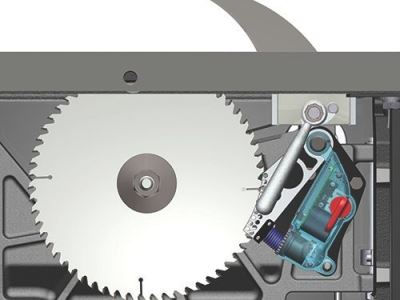In 1999, Steve Gass founded SawStop LLC, a table saw manufacturing company. Distinguishing SawStop from other saw manufacturing companies is its injury-preventing technology: by means of a small current of electric voltage sent through the saw, the saw is able to tell the difference between wood and flesh, as flesh disrupts the current while wood does not. As a result, the saw is able to stop within five milliseconds of contact with flesh, resulting in a small nick to flesh rather than a full amputation. Such technology, if used pervasively, undoubtedly would result in a hugely increased safety margin for consumers who purchase and utilize table saws. In fact, the Consumer Products Safety Commission (CPSC) awarded a “safety commendation” to SawStop, LLC. However, due to the marginal increase in cost of manufacturing, manufacturers have been less than or completely unwilling to incorporate this revolutionary technology into their saws.
Table Saw Injury Statistics
The CPSC estimates that about 54,000 injuries involving power saws and 72,000 involving table or bench saws occurred during the 2007-2008 year alone. Given this high number, and the fact that manufacturers of table saws have not yet adopted this (undisputedly safer) technology, refusing to incorporate SawStop’s technology into table saws amounts to an act of negligence by the manufacturer.
Legal Rights of Those Injured
Consumers injured by a table saw unequipped with SawStop technology may be able to recover under either “design defect” or “negligence” theories of liability.
With respect to the design defect theory, there exist two different tests in California for determining whether a defendant can be held liable for a design defect. The first is the “risk benefit test” under which a plaintiff must prove the following before liability may be imposed:
- the defendant manufactured, distributed, or sold the product,
- the plaintiff was harmed, and
- the design of the product was a “substantial factor” in causing the plaintiff’s harm.
Once these three facts are proved, then the plaintiff must prevail unless the defendant shows that the benefits of the design outweigh its risks.
The second test is the “consumer expectations test” under which liability can be imposed if plaintiff shows the following:
- the defendant manufactured, distributed, or sold the product,
- the product did not perform with the level of safety a normal consumer would expect it to when used or misused in a foreseeable way,
- the plaintiff was harmed,
- the product’s failure to safely perform was a “substantial factor” in causing the plaintiff’s harm.
These two tests are alternatives and a defendant can be held liable if either test is satisfied. Failure to satisfy one test cannot be used as a defense, should the defendant satisfy the other one.
Therefore, under a design defect theory of product liability, if a court finds that the benefit of a saw designed without SawStop technology does not outweigh the risk, a consumer injured by a saw that was unequipped with SawStop can hold the manufacturer liable for his or her injuries. Alternatively, if a court finds that a reasonable consumer would expect the saw to contain SawStop or similar technology, the consumer can similarly recover.
For the negligence theory of liability, a manufacturer is negligent if it fails to use the amount of care in designing/manufacturing a product that a reasonable manufacturer would use in similar circumstances to avoid exposing consumers to foreseeable danger. If a court finds that a reasonable manufacturer would design its saws with SawStop to prevent foreseeable harm to consumers, consumers injured by saws that don’t have SawStop technology can recover from the manufacturer for their injuries.
If you or a loved one has suffered injury resulting from a saw accident, and the saw lacked SawStop or similar technology, contact our office.


